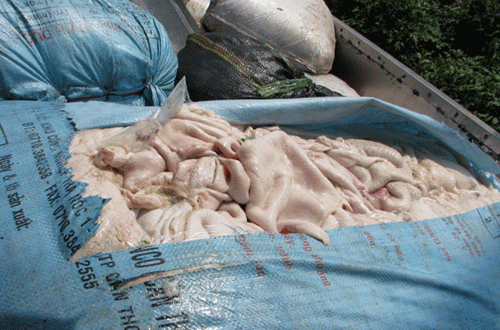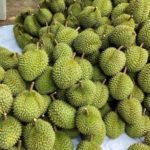Here are some tips to distinguish chemically treated fruits from naturally ripe fruits.
Durian: Ripe durian can be easily separated by hand, has a very distinctive and big thorn. When squeezed, the thorns are still small and not fully bloomed, so you need to use a knife to separate them. Ripe durian has a bland taste without the distinctive aroma.

related news
Nearly 1 ton of chemically soaked pig skin discovered
The inspection team from the Department of Agriculture and Rural Development of Long An province on October 4 conducted an inspection of a pig skin processing facility at No. 258, Hamlet 4, Thanh Loi Commune, Ben Luc District, owned by Mrs.Doa…
Banana: Chemically treated bananas have a shiny yellow color, feel powdery on the surface, have green stems, and have a black core. They have a bland taste.
Jackfruit: Naturally ripe jackfruit has a rough and dark skin, fully bloomed eyes with sparse thorns, consistent color throughout, slightly pale yellow fibers, a sweet and fragrant taste. When squeezed, ripe jackfruit has a green outer skin, sharp thorns, and it is hard to separate; the inside is ripe with yellow flesh to fiber, the flesh is slightly bland.
Mango: Avoid buying mangoes with green or light yellow skin but ripe yellow flesh, many fruits have white or brown spots or stains on the outer skin as these are mangoes ripened with chemicals.
Lychee: Lychees sprayed with sulfur for long-term preservation often have an even and shiny skin, round shape, no natural roughness, when eaten the flesh is crisp, firm, and lacks the characteristic sweet taste.
Rambutan: When buying rambutans, check the small fruits, if they are crushed like when they are left for a long time, when separated, there will be a lot of water flowing out, the flesh layer shows signs of foam-like texture, so they should not be purchased.
You may also like
Know When Durian Season Begins and Ends in Singapore
It’s that time of the year again – durian season! From May to August, the unmistakably pungent aroma of these delicious fruits will be filling the air, signaling the start of the season. Gather your friends and family, and get ready to bask in durian goodness!



































